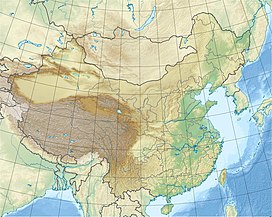Greater Khingan
This article includes a list of general references, but it lacks sufficient corresponding inline citations. (March 2014) |
| Greater Khingan Range | |
|---|---|
 Forest in Genhe, Inner Mongolia | |
| Highest point | |
| Elevation | 2,035 m (6,677 ft) |
| Coordinates | 49°22′57″N 123°09′24″E / 49.3823728°N 123.1567383°E |
| Naming | |
| Native name | 大兴安岭 (Chinese) |
| Geography | |
Located in Northeast China | |
| Geology | |
| Mountain type | Tilted block faulting |
The Greater Khingan Range or Da Hinggan Range (simplified Chinese: 大兴安岭; traditional Chinese: 大興安嶺; pinyin: Dà Xīng'ān Lǐng; IPA: [tâ ɕíŋ.án.lìŋ]) is a 1,200-kilometer-long (750 mi) volcanic mountain range in the Inner Mongolia region of Northeast China.[1] It was originally called the Xianbei Mountains, which later became the name of the northern branch of the Donghu, the Xianbei.[2][3][4]
Geography
[edit]The range extends 1,200 kilometers (750 mi) from north to south. It is the watershed between the Nen and Songhua river systems to the east, and the Amur and its tributaries to the northwest.[5]
Population
[edit]Its slopes are a relatively rich grazing area. The Khitan people lived on the eastern slopes[6] before establishing the Liao Dynasty in the tenth century. Oroqen, a Tungusic people, live along the Greater and Lesser Khingan range in northeastern China and belong to the oldest autochthonous populations of the region. On the western slopes lived the nomadic people, who raised sheep and camels and used the Mongolian plateau for their pastoralist economy.[6]
In fiction
[edit]The Greater Khingan Range is a key setting in the science fiction novel The Three-Body Problem (novel) by Chinese author Liu Cixin.
See also
[edit]References
[edit]- ^ "The Greater Khingan range in winter". China Daily. 28 December 2015. Retrieved 30 December 2015.
- ^ Hou Hanshu volume 90 "鮮卑者,亦東胡之支也,別依鮮卑山,故因號焉" "the Xianbei people branched off from the so-called 'Eastern Hu' and came to settle around Mt. Xianbei after which name they were designated" translated by Toh (2005)
- ^ Weishu volume 1
- ^ Tseng, Chin Yin (2012). The Making of the Tuoba Northern Wei: Constructing Material Cultural Expressions in the Northern Wei Pingcheng Period (398–494 CE) (PhD). University of Oxford. p. 1.
- ^ "Da Hinggan Range". Encyclopaedia Britannica. Retrieved 17 September 2020.
- ^ a b Mote, F.W. (1999). Imperial China: 900–1800. Harvard University Press. p. 32s. ISBN 0-674-01212-7.
Further reading
[edit]- Kropotkin, Peter Alexeivitch; Bealby, John Thomas (1911). . In Chisholm, Hugh (ed.). Encyclopædia Britannica. Vol. 15 (11th ed.). Cambridge University Press. p. 777.

